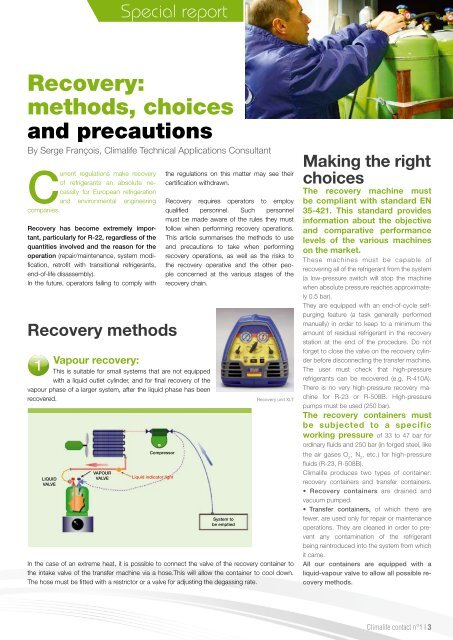Climalife Contact - Dehon - Climalife
Climalife Contact - Dehon - Climalife
Climalife Contact - Dehon - Climalife
You also want an ePaper? Increase the reach of your titles
YUMPU automatically turns print PDFs into web optimized ePapers that Google loves.
Recovery:<br />
methods, choices<br />
and precautions<br />
By Serge François, <strong>Climalife</strong> Technical Applications Consultant<br />
Current regulations make recovery<br />
of refrigerants an absolute necessity<br />
for European refrigeration<br />
and environmental engineering<br />
companies.<br />
Recovery has become extremely important,<br />
particularly for R-22, regardless of the<br />
quantities involved and the reason for the<br />
operation (repair/maintenance, system modification,<br />
retrofit with transitional refrigerants,<br />
end-of-life disassembly).<br />
In the future, operators failing to comply with<br />
Recovery methods<br />
This is suitable for small systems that are not equipped<br />
with a liquid outlet cylinder, and for final recovery of the<br />
vapour phase of a larger system, after the liquid phase has been<br />
recovered.<br />
LIQUID<br />
VALVE<br />
Vapour recovery:<br />
VAPOUR<br />
VALVE<br />
Special report<br />
Compressor<br />
Liquid indicator light<br />
the regulations on this matter may see their<br />
certification withdrawn.<br />
Recovery requires operators to employ<br />
qualified personnel. Such personnel<br />
must be made aware of the rules they must<br />
follow when performing recovery operations.<br />
This article summarises the methods to use<br />
and precautions to take when performing<br />
recovery operations, as well as the risks to<br />
the recovery operative and the other people<br />
concerned at the various stages of the<br />
recovery chain.<br />
System to<br />
be emptied<br />
Recovery unit XLT<br />
In the case of an extreme heat, it is possible to connect the valve of the recovery container to<br />
the intake valve of the transfer machine via a hose.This will allow the container to cool down.<br />
The hose must be fitted with a restrictor or a valve for adjusting the degassing rate.<br />
Making the right<br />
choices<br />
The recovery machine must<br />
be compliant with standard EN<br />
35-421. This standard provides<br />
information about the objective<br />
and comparative performance<br />
levels of the various machines<br />
on the market.<br />
These machines must be capable of<br />
recovering all of the refrigerant from the system<br />
(a low-pressure switch will stop the machine<br />
when absolute pressure reaches approximately<br />
0.5 bar).<br />
They are equipped with an end-of-cycle selfpurging<br />
feature (a task generally performed<br />
manually) in order to keep to a minimum the<br />
amount of residual refrigerant in the recovery<br />
station at the end of the procedure. Do not<br />
forget to close the valve on the recovery cylinder<br />
before disconnecting the transfer machine.<br />
The user must check that high-pressure<br />
refrigerants can be recovered (e.g. R-410A).<br />
There is no very high-pressure recovery machine<br />
for R-23 or R-508B. High-pressure<br />
pumps must be used (250 bar).<br />
The recovery containers must<br />
be subjected to a specific<br />
working pressure of 33 to 47 bar for<br />
ordinary fluids and 250 bar (in forged steel, like<br />
the air gases O 2 , N 2 , etc.) for high-pressure<br />
fluids (R-23, R-508B).<br />
<strong>Climalife</strong> produces two types of container:<br />
recovery containers and transfer containers.<br />
• Recovery containers are drained and<br />
vacuum pumped.<br />
• Transfer containers, of which there are<br />
fewer, are used only for repair or maintenance<br />
operations. They are cleaned in order to pre-<br />
vent any contamination of the refrigerant<br />
being reintroduced into the system from which<br />
it came.<br />
All our containers are equipped with a<br />
liquid-vapour valve to allow all possible recovery<br />
methods.<br />
<strong>Climalife</strong> contact n°1 I 3






